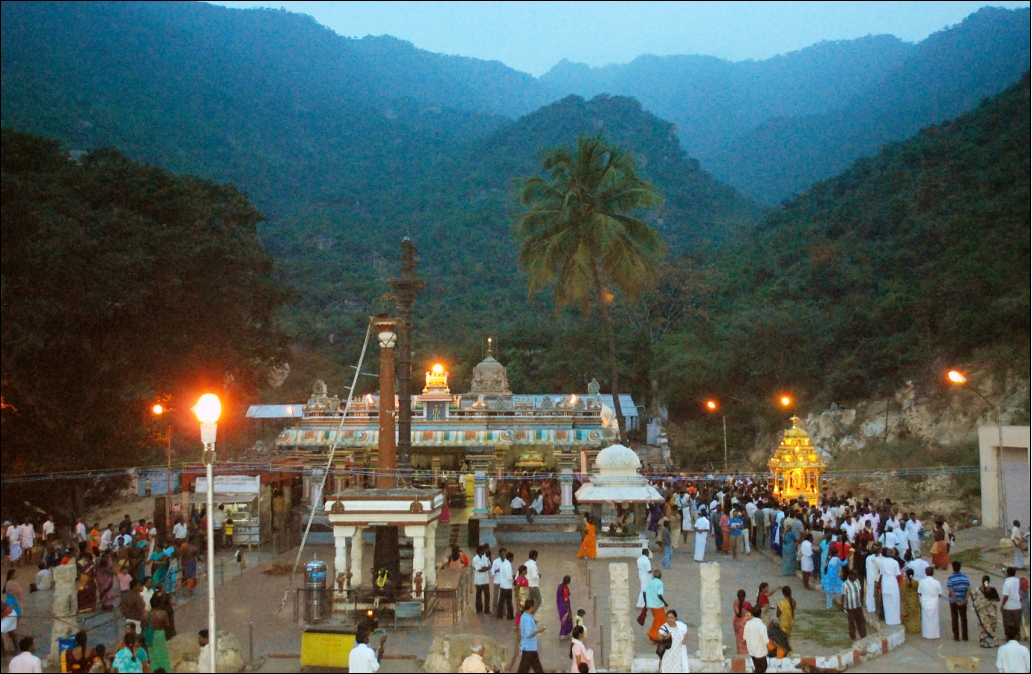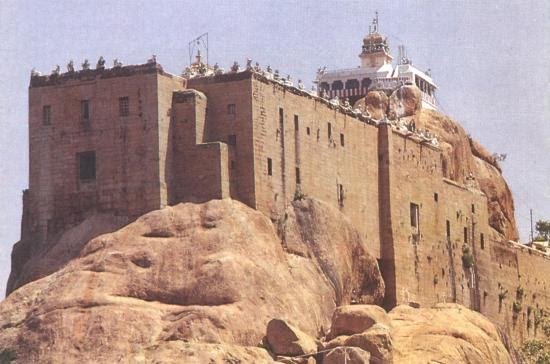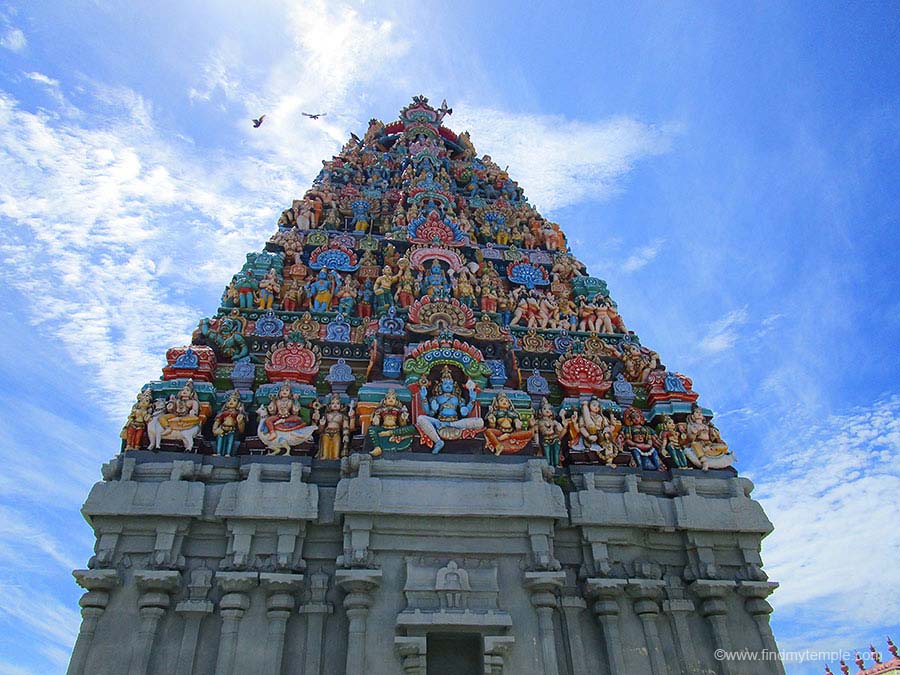Main God :
Arulmigu Subramanya Swamy

Location :
1. Chittirai Vishu
2. Chitra Pournami
3. Vaikasi Visakam
4. Aadi Amavasai
5. Aadi Kritigai
6. Kandar Shasti Soorasamharam
7. Karthigai Deepam
8. Thai Poosam- Ratham Ula
9. Panguni Uthiram – Ratham Ula
Devotees on Special Dharshan Days
On days like Chitirai Vishu, Vaikasi Visakam, Aadi Kritgai, Kandar Shasti Soorasamharam, Tirukarthigai, Panguni Uthiram thousands of devotees visit the temple. Every month on days like Amavasya, Shasti, Kritigai, Pournami hundreds of devotees visit the temple.
Thai Poosam Chariot Festival
The Chariot festival held on the Poosa Nakshatra of the Tamil Month ‘Thai’, is a biggest event in the district. It is celebrated with fervor for 15 days. Starting from the day the flag is hoisted, each day devotees belonging to a community take turns and carry out Annadana at their Madam. On the 8th day evening after flag hoisting, Vasantha Tirukkalyana Urchavam and on the 9th and 10th day Chariot Festival, 11th day Parivettai, 12th day Theppa Ther, 13th day Sattavaram (Grand darshan Procession) and come to a close on 14th day with Manjal Neer Urchavam. Devotees from all over the world visit the temple by ‘Padayatra’, observe ‘Vratam’ or carry different kinds of ‘Kavadi’. Approximately, 10 Lakh devotees pay their obeisance each year. On these special days, ’Annadanam’ and special Cultural Events are held. Similarly, during the tamil month of ‘Panguni’, on the ‘Uthra’ Star ‘Big Wooden Chariot’ Festival is held. This festival is celebrated for 6 days. Having two Chariot festivals in a year is unique to Chennimalai.
Workship Timing :
Gopuja is done at 5.30 A.M daily and the hill temple sannadi is opened for Swami Dharshan and Pooja from 6.00 A.M. to 8.00 P.M without any intermission. The temple is closed at 8.15 P.M after the Ardhajama pooja.

Temple :
Once upon a time Anandan a.k.a Nagarjuna and Vayu Deva were contending that each of them to be superior and important. So there was a fight between them to prove their strength. When Anandan embraced Mahameru (Big hill) and held firmly, Vayu Deva responded by blowing strongly. As a result, head (Peak) of Mahameru was blown away and fell at Poondurai (Today’s Perundurai) town. This peak of Mahameru is known as Sira giri, Sigara giri, Pushpa giri, Makutagiri or Chennimalai(The head of hills).
History :
. About 3 miles from Chennimalai, on the banks of Noyyal River, there is a village named ‘Kodumanal’. It was once a flourishing ancient trade city known as Kodumanam, as inscribed in Patittrupathu of Sangam literature. The place is an important archaeological site, under the control of State Archaeological Department of Tamil Nadu. Archaeological Survey suggests that, once upon a time, this village used to be a big town and was ruled by a petty king. The research on this subject is still continuing to unearth more information.
Hundreds of years ago there lived a Land lord in this town who had hundreds of dairy cows in his farm, one among them was a Black Colour Cow (Karam Pasu). Every day the cowherd locks up all the cows in the evening after they have grazed the whole day. The cowherd noticed that there was no milk in the udder of the Karam Pasu for a few days and informed this to the Land Lord. The land lord also observed for some time that during the evening, when all the cows come back after grazing, this Karam Pasu used to separate from the rest and proceed to a particular spot and discharge the milk by itself. He decided to dig the spot where the cow flows its milk every day.
On digging about 5 to 6 ft a beautiful Statue of Lord Muruga was found. He was ecstatic on finding the idol. Further, he noticed that idol was beautifully sculpted upto the hip and the lower portion was rough. The best artisan was summoned to complete the job. Everyone was shocked to see that on the first chisel, the idol started to bleed. The land lord realized that this is God’s will to be the way it was. So he consecrated this idol of Lord Dandayudapani on a nearby hill, which is today known as Chennimalai hill. Even today one can see lower portion of the Moolavar Vigraham is still the same way.

2. The temple is dated approximately 3000 years back, constructed during the King ‘Sivalaya Chola’ period. It is said that this King, while on a pilgrimage to get rid of ‘Brahmahatti Dosha’, was taking bath in the river Noyyal, saw this hill, climbed the hill along with his troops and entered the temple. Lord Muruga appeared in the form of an ‘Archagar’ and performed Puja on himself and relieved King Sivalaya Chola of Brahmahatti Dosha. It is also said that King Sivalaya Chola, brought a Tirumaraiyaar by the name of ‘Deivasigamaniyaar’, from Tirukadavur to stay at Tiruvirundapuram (Pidariyur).
3. Poet Saint Saravana Munivar, born in a family of ‘Sivamaraiyaars’ and Disciple of ‘SathiyaGnani’, wanted to learn the history of Chennimalai and prayed God to help him. Then through a Divine Prompting Voice, Lord Muruga directed him to proceed to Kancheepuram and seek the information from the Maraiyavars. Thus, Saravana Munivar collected the history of Siragiri from the Copperplate inscriptions with the Maraiyavars and transcribed the contents and brought it to Chennimalai. He was wonder struck to note the depiction in the Sthalapuranam come alive when he reached Chennimalai. The Chennimalai Sthalapuranam has 207 verses including the invocation songs and is divided into six cantos. They are Chepêdu Kanda Mānmiyam, Siragiri Mānmiyam, Pushpagiri Mānmiyam, Kātchi Mānmiyam, Idumbanuku Vazhi Kātiya Mānmiyam, ālayam Kanda Mānmiyam. The author of this great work is the poet Saint Saravana Munivar. Lord Muruga appeared in front of him in two forms, with one face and six faces. The Samadhi of Saravana Munivar is at the hill temple.
4. When Paarvathy’s Marriage was to happen at Himalayas, all devotees were expected to congregate at the northern end and hence, the southern end would be raised. Lord Shiva directed ‘Agasthya Munivar’ to proceed to Podigai Hill in southern end. Agasthya asked whether he should not be watching the Marriage event, to which, Lord Shiva replied that since all would be moving towards the northern end, only if you proceed to the southern end will the earth balance. He also said that the marriage function will be shown to Agasthya at Podigai Hills.
Accordingly, while Agasthya was proceeding to the southern end, Idumbaasura (Leader of Asuraas like Soorapadhman), met him and requested to be accepted as a disciple. He also asked Agasthya as to what he can do for him to which Agasthya replied, ‘While coming south in a hurry, I have forgotten to get my ‘Sivapooja’ in the hills, you go there and get it for me’. Idumbaasura could not locate the ‘Sivapooja’, therefore, he carried the two hills (Sivagiri and Sathyagiri) in a ‘Kaavadi’ from there. He lost his way enroute and reached Chennimalai. Then, during ‘Dwapara Yuga’, Chennimalai was known as ‘Pushpagiri’. Lord Muruga appeared before Idumbaasura in the form of a ‘RajKumar’ and showed the way to Podigai Hills. The hills carried by Idumbaasura in a Kaavadi is today’s ‘Pazhaniyampaadi’.

5. Moolavar is manifested in the form of ‘Dandayudapani’. Contrary to regular practice, here Moolavar pooja and Nivedya precedes that of Lord Vinaya in the temple premises. It is Ancient Lore that since Lord Muruga was angry that Mango was not given to him and is seated in this hill, Nivedya and Pooja is performed first to Lord Muruga to pacify him..jpg)







